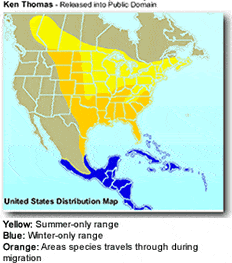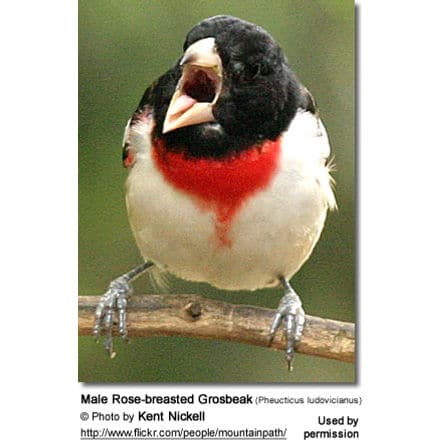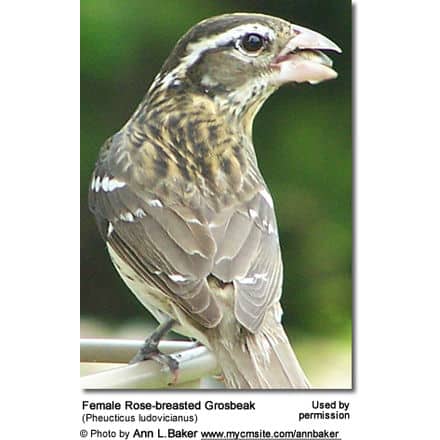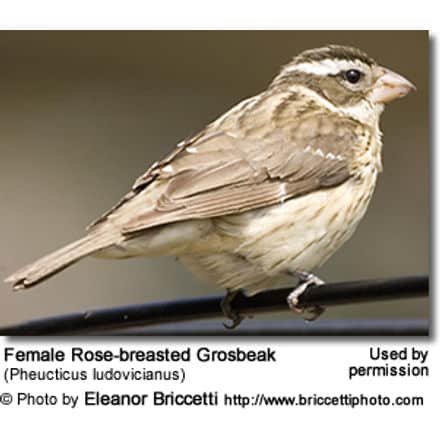Rose-breasted Grosbeaks, Pheucticus ludovicianus
The Rose-breasted Grosbeaks (Pheucticus ludovicianus) – also known as Common Grosbeak or Purple-breasted Grosbeak – is a large seed-eating member of the cardinal family.
It is one of five grosbeak species found in North America, where they are common birds of forests and second growth.
It is an economically beneficial species as it consumes large numbers of destructive insect pests, such as grasshoppers, cankerworms, tent caterpillars, tussock moths, gypsy moths, brown-tailed moths and the Colorado potato beetle.
Unfortunately, populations are declining in many areas, especially in the east.
Their life expectancy in the wild is 9 or more years; captive birds have lived from 15 to 24 years.
Alternate (Global) Names
Spanish: Candelo tricolor, Degollado, Picogordo Degollado, picogordo pecha rosa, Picogordo Pechirrojo, Picogordo Pecho Rosa, Picogrueso Pechirrosado, Pico-grueso Rosado, Piquigrueso Degollado, Piquigrueso Pechirrosado, Piquigrueso pecho rosadoo … Portuguese: Bico-grosso-tricolor … Italian: Beccogrosso pettorosa, Peccogrosso pettorosa … French: Cardinal à poitrine rose, Casse-graine à poitrine rose, Gros-bec à poitrine rose, Grosbec de la Louisiane, Gros-bec de la Louisiane, Guiraca à poitrine rose, Rosegorge … Latin: Habia ludoviciana, Hedymeles ludovicianus, Pheuctictus ludovicianus, Pheucticus ludovicianus, Pheutictus ludovicianus, Zamelodia ludoviciana … Czech: dlaskovec r?žovoprsý, Kardinál ružovoprsý … Welsh: Gylfindew brongoch … Danish: Rosenbrystet Kernebider … German: Rosenbrust-Kernkancker, Rosenbrust-Kernknacker … Estonian: hund-kuhiknokk … Finnish: Punarintakardinaali … Faroese: Vongbrigðureyður kjarnbítur … Irish: Gobach Mór Broinnrósach … Haitian Creole French: Kadinal fal wòz … Hebrew: ????? … Icelandic: Tígultáti … Japanese: muneakaikaru or ??????? … Lithuanian: Raudonkr?tis svil?nas … Maltese: Bumunqar Amerikan … Dutch: Roodborst kardinaal, Roodborstkardinaal … Norwegian: Rosenbrysttykknebb, Rosenbryst-tykknebb … Polish: luszcz strojny,?uszcz strojny … Russian: ???????????? ??????????? ????????, ???????????? ???????? … Slovak: Glezgovec ružovoprsý … Slovenian: rde?eprsi kardinal … Swedish: Brokig kardinal …Turkish: al gö?üslükocaba?, Al-gö?üslü Kocaba? … Chinese: ??????

Distribution / Range:
The Rose-breasted Grosbeak is a medium-distance migrant. It breeds in open deciduous woods across most of Canada and the eastern United States.
Northern populations migrate to southern Mexico south through Central America to Peru and Venezuela in winter.
They may occur as very rare vagrants to Western Europe.


Description:
These medium-sized, stocky songbirds measure 7-8.5 in (18–22 cm) in length and have a wingspan of 12 to 13 inches (30 – 33 cm). They typically weigh 1.3 – 2 oz (38 – 54 g).
Characteristic for the Grosbeak is the massive, dusky horn-colored, cone-shaped bill. It has dark feet and eyes
The breeding adult male has a heavy bill, black head, wings and upper plumage. He has a a bright rose-red triangular patch on his chest. His black wings have white patches and rose red linings. He is mostly white below. His rump is white, sometimes pink – usually with some dark markings.
The non-breeding male looks similar to the breeding male, but his black feathers on the back have buff tips that partially hide the black. On the head, these buff tips create a buff center crown-stripe and face stripes. His throat and chin are mottled black and pink. His pink chest is dull. He somewhat resembles the female, but his wings are wings and tail are black with white.
Immature males look more like the female, but can be differentiated by the rosy patch on his brownish chest, usually with some pink markings. He has red wing linings.

The adult female has a duller plumage and resembles a large sparrow or finch. She has dark greyish/brownish upper plumage. She has brown streaks on the cream or buff-colored chest. Her neck, sides and flanks are also cream or buff-colored, with narrow or heavy black streaks. Her under tail is white and upper tail is brown. Her rump olive brown. She has two white wing bars and yellowish to orange wing linings.
Immature birds resemble the adult female, but their wings and tails are browner; the chest is more buffy and with more indistinct streaking.
Similar species
The Rose-breasted Grosbeak female resembles the Purple Finch female; however, the purple finch is generally smaller and has a smaller head. It also has a moustache stripe, a dark bill, and lacks white in wings.The Black-headed Grosbeak female is very similar to female Rose-breasted Grosbeak; except the Black-headed Grosbeak has less streaking on the under plumage, particularly in the center of chest. The head and nape is more yellowish buff rather than white. The wing linings are lemon yellow rather than buff. The upper bill is dark.
Diet / Feeding
The Rose-breasted Grosbeak feed on grasshoppers, cankerworms, tent caterpillars, tussock moths, gypsy moths, brown-tailed moths, the Colorado potato beetle, and other insect pests. They also eat seeds and berries.
They usually forage in shrubs or trees and may also catch insects in flight.

Nesting:
Rose-breasted Grosbeaks typically breed in scrub woodland and shrubby growth by streams and wooded edges, where they build their loose cup nest out of twigs and grasses and place it in a tree or large shrub. Most of the nest construction is performed by the female, however, with some assistance from the male.
The average clutch consists of 3 to 5 eggs, which are incubated by both parents. The young hatch after about 12 to 14 days of incubation and are cared for by both parents. They fledge when they are about 9 to 12 days old and are independent after about 3 weeks or so..
Where ranges overlap, Rose-breasted Grosbeaks will hybridize with the western Black-headed Grosbeak.

Calls / Vocalizations
The Rose-breasted Grosbeaks call is a sharp pink. Its song has been described as a more refined version of the American Robin‘s song – except being mellower and more melodic.
The male’s song is long, liquid and robin-like; the female has shorter, softer song.



